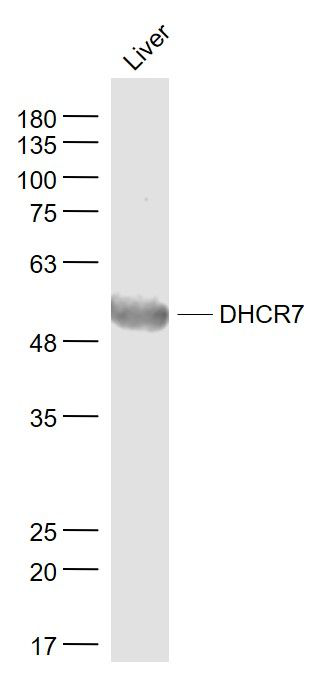产品货号 : mlR5057
英文名称 : DHCR7
中文名称 : 脱氢胆固醇还原酶7抗体
别 名 : 7 dehydrocholesterol reductase; 7 DHC reductase; Delta 7 dehydrocholesterol reductase; Putative sterol reductase SR 2; Sterol Delta; DHCR7_HUMAN.
研究领域 : 肿瘤 细胞生物 免疫学 转录调节因子
抗体来源 : Rabbit
克隆类型 : Polyclonal
交叉反应 : Human, Mouse, Rat, Chicken, Dog, Cow, Horse,
产品应用 : WB=1:500-2000 ELISA=1:500-1000
not yet tested in other applications.
optimal dilutions/concentrations should be determined by the end user.
分 子 量 : 54kDa
细胞定位 : 细胞浆 细胞膜
性 状 : Lyophilized or Liquid
浓 度 : 1mg/ml
免 疫 原 : KLH conjugated synthetic peptide derived from human DHCR7:351-450/475
亚 型 : IgG
纯化方法 : affinity purified by Protein A
储 存 液 : 0.01M TBS(pH7.4) with 1% BSA, 0.03% Proclin300 and 50% Glycerol.
保存条件 : Store at -20 °C for one year. Avoid repeated freeze/thaw cycles. The lyophilized antibody is stable at room temperature for at least one month and for greater than a year when kept at -20°C. When reconstituted in sterile pH 7.4 0.01M PBS or diluent of antibody the antibody is stable for at least two weeks at 2-4 °C.
PubMed : PubMed
产品介绍background:
The DHCR7 gene encodes delta-7-sterol reductase (EC 1.3.1.21), the penultimate enzyme of mammalian sterol biosynthesis that converts 7-dehydrocholesterol (7-DHC) to cholesterol.
Function:
Production of cholesterol by reduction of C7-C8 double bond of 7-dehydrocholesterol (7-DHC).
Subcellular Location:
Endoplasmic reticulum membrane; Multi-pass membrane protein.
Tissue Specificity:
Most abundant in adrenal gland, liver, testis, and brain.
DISEASE:
Defects in DHCR7 are the cause of Smith-Lemli-Opitz syndrome (SLOS) [MIM:270400]; also known as SLO syndrome or RSH syndrome. SLOS is an autosomal recessive frequent inborn disorder of sterol metabolism with characteristic congenital malformations and dysmorphias. All patients suffer from mental retardation. Children with SLOS have elevated serum 7-dehydrocholesterol (7-DHC) levels and low serum cholesterol levels. SLOS occurs in relatively high frequency: approximately 1 in 20,000 to 30,000 births in populations of northern and central European background. Historically, a clinical distinction often was made between classic ('type I') SLOS and the more severely affected ('type II') patients. There is, in reality, a clinical and biochemical continuum from mild to severe SLOS.
Similarity:
Belongs to the ERG4/ERG24 family.
SWISS:
Q9UBM7
Gene ID:
1717
Important Note:
This product as supplied is intended for research use only, not for use in human, therapeutic or diagnostic applications.
产品图片












